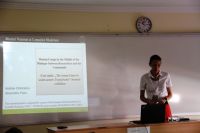The 20th European Association of Archaeologists (EAA) Annual Meeting (website) took place on the 10th – 14th of September 2014.

Andrea Chiricescu and Dr. Hab. Alexandru Popa talked about Roman camps in the middle of the dialogue between researchers and the community: Case-study – “The Roman Limes in eastern Transylvania” exhibition, for and by second grade students”.
In this presentation the authors presented a work-in-progress – a didactic, interactive exhibition for second grade students, developed with their direct implication, on the theme of the Roman Limes, as a community archaeology project. The students working on completing the exhibition and its interactive elements were given all the necessary scientific information by the researcher himself. Specific attention was given to the results of the researches conducted in the last two years, as part of the "Roman Border in Eastern Dacia Province" project, supported by a grant of the Romanian National Authority for Scientific Research, CNCS – UEFISCDI, project number PN-II-ID-PCE-2011-3-0652, contract nr. 339/5.10.2011.. With the help of communication specialists these results were “translated” for the chosen target group, in a way the scientific message could reach its goals.
Abstract:In Romania the terms of community and public archeology are rarely discussed as we are still in search of defining these concepts. Meanwhile, the archaeological projects that involve public participation are emerging considerably. Specialists show large interest in tying communication with the communities through a dialogue that revolves around archaeological finds. Although public participation in archaeological projects is not a tradition in Romania our main interest is to encourage people to participate more than they do today. Thus, we are taking small steps in rising awareness among those local communities that live on or very close to a Roman camp, in the eastern part of Transylvania. In this purpose we are working on establishing a dialogue with both descent and non-descent local communities, by trying to involve them in the planning and carrying out of archaeological projects that are of their direct interest. In our case history and ethnic mixture and development of Transylvanian local communities play a very important role in defining community archaeology, in terms of establishing their ancestral link to a site. Our case study shows one of the ways the younger generation can be involved in discovering, interpreting and presenting a piece of local history.
For further information related to the Meeting:
The full scientific programme
The abstracts of all the papers presented in the 6 main thematic sessions